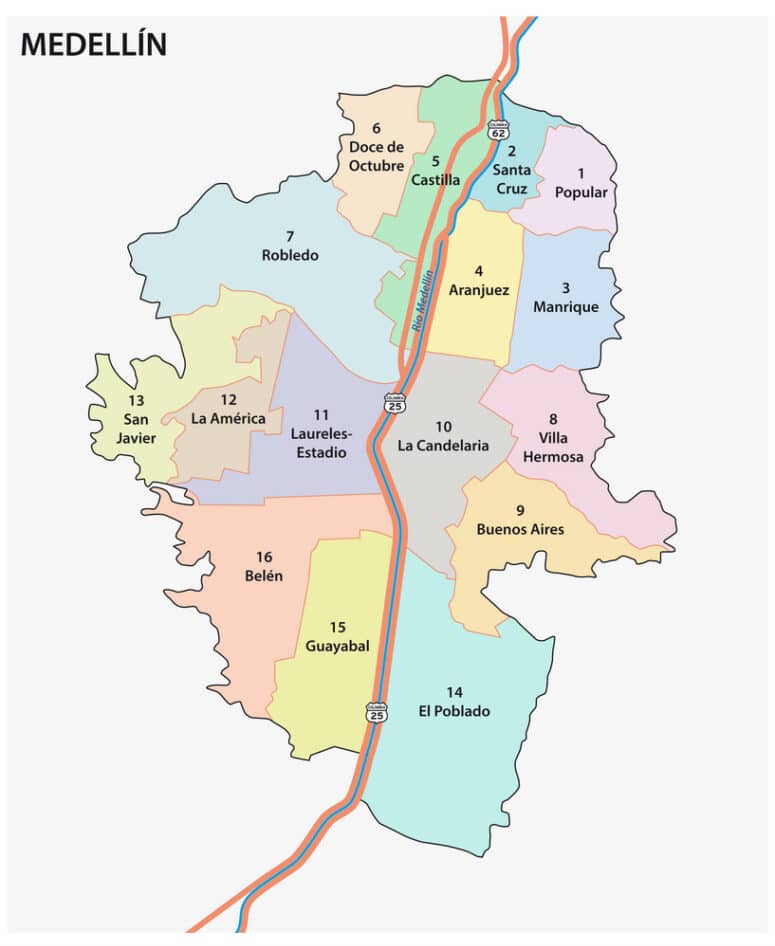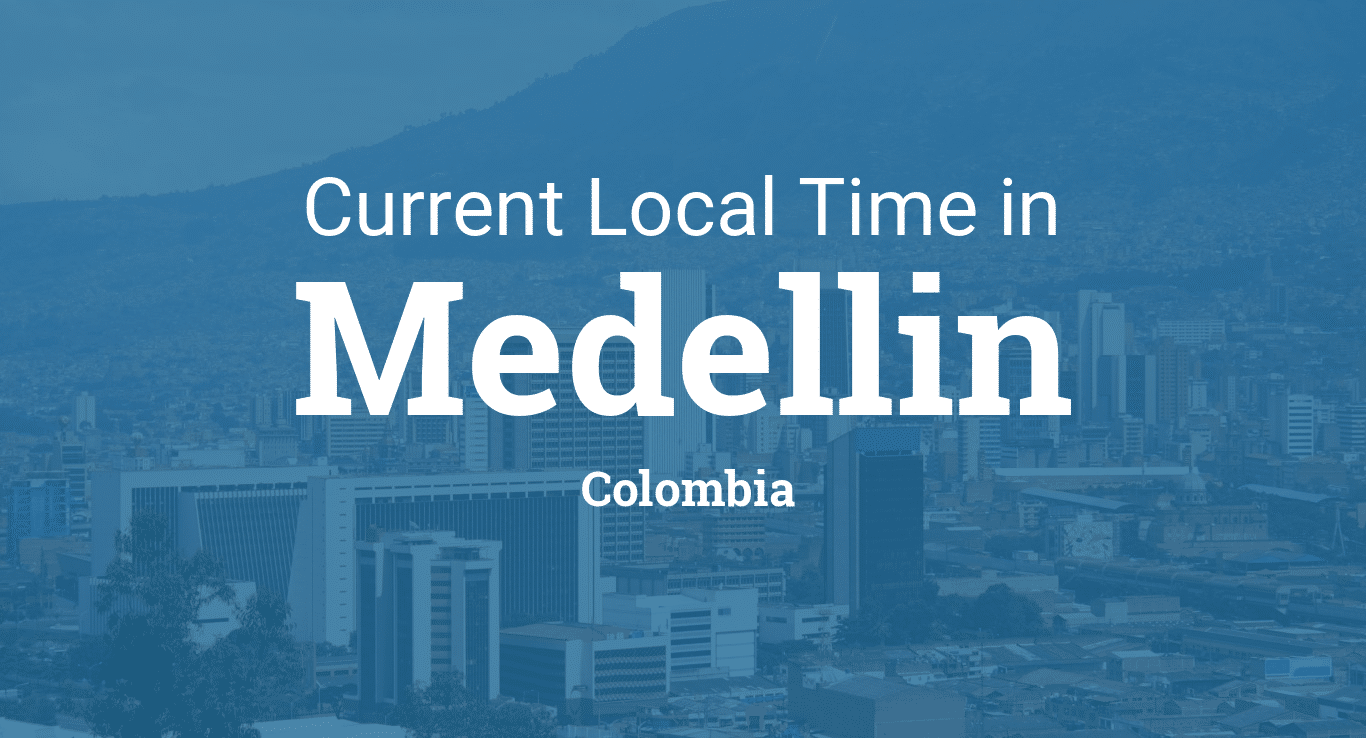Introduction
Nestled in the heart of Colombia, the Medellin Metropolitan Area, also known as the Aburra Valley, is a vibrant and bustling urban region that attracts tourists and expats alike. With its 10 municipalities and 16 unique neighborhoods, or comunas, within the city of Medellín, there’s something for everyone in this thriving cityscape. In this blog post, we’ll delve into the cities and comunas that make up the Medellín Metropolitan Area, exploring the distinct characteristics of each area to help you better understand this exciting region.
10 Cities in the Medellín Metropolitan Area:
Medellín
Expats Interest Points in Medellín
Medellín, the capital of Antioquia department, is the crown jewel of the valley. It’s known as the ‘City of Eternal Spring’ for its amiable climate. For expats, Medellín offers an engaging mix of cultural experiences and a high standard of living. The city boasts a robust healthcare system, a thriving international community, and a vast array of restaurants and shopping centers. The Poblado district, in particular, is a popular location for expats.
Bello
Expats Interest Points in Bello
Bello is the second largest city in the Aburrá Valley. It’s known for its beautiful parks and squares, such as Parque Bello and Parque de los Cerros. Bello also has a vibrant commercial center with plenty of opportunities for shopping and dining. For expats, the city offers affordable living conditions and a slower pace of life compared to Medellín.
Envigado
Expats Interest Points in Envigado
Envigado may be smaller than its neighboring cities, but it doesn’t lack charm or amenities. It’s known for its relaxed atmosphere, friendly locals, and superb food scene. Expats often gravitate towards the area for its tranquility and family-friendly environment. The Envigado Park is a popular spot for both locals and expats to relax and enjoy outdoor activities.
Itagüí
Expats Interest Points in Itagüí
Itagüí is recognized for its industry and commerce. The city is smaller and less bustling than Medellín, making it an attractive option for those seeking a quieter lifestyle. For expats, Itagüí offers a range of modern apartments, local markets, and easy access to Medellín via the efficient metro system.
Sabaneta
Expats Interest Points in Sabaneta
Sabaneta, once a humble farming village, has transformed into a lively city that still manages to hold onto its charming, small-town feel. The city’s main park, Parque Sabaneta, is a focal point of community life with a variety of restaurants and shops surrounding it. Expats will find Sabaneta to be a blend of traditional and modern lifestyles.
La Estrella
Expats Interest Points in La Estrella
La Estrella is a calm, serene city south of Medellín. The city offers expats a quieter lifestyle with lower living costs. Additionally, La Estrella is known for its lush landscapes, outdoor activities, and weekend farmers markets. Its tranquility and accessibility to Medellín make it a great place for expats seeking peace without being too far from the bustle of the city.
Caldas
Expats Interest Points in Caldas
Caldas is the southernmost city of the metropolitan area. This city, while being part of the urban network, preserves a semi-rural essence that could be appealing for expats who enjoy a countryside atmosphere. Moreover, Caldas offers affordable housing options, and its strong community bond provides a welcoming environment for newcomers.
Copacabana
Expats Interest Points in Copacabana
Copacabana is a town located north of Medellín, known for its hillside neighborhoods offering fantastic views over the valley. For expats, it offers a small-town lifestyle with easy access to urban conveniences due to its close proximity to both Bello and Medellín. Moreover, its central park is a delightful gathering point with coffee shops and restaurants around.
Girardota
Expats Interest Points in Girardota
Girardota, located northeast of Medellín, is a destination for expats interested in agrotourism and horseback riding. It has a warmer climate and a variety of outdoor attractions such as the Cauca Viejo Ecotourism Park. Girardota’s charm lies in its traditional paisa architecture and small-town community feel.
Barbosa
Expats Interest Points in Barbosa
Barbosa, the northernmost city of the metropolitan area, is a favorite weekend destination for residents of the Aburrá Valley. Its warm climate, rivers, and ecological trails offer a great environment for nature lovers. Expats might appreciate Barbosa for its rural charm combined with an increasing number of urban amenities.
Geography
Location and Characteristics
Located in the central Andes Mountains of Colombia, the Metropolitan Area of the Aburrá Valley is a region of fascinating geography. The valley runs from the south to the north, spread across an area of about 1,152 square kilometers. The landscape is characterized by rolling hills, steep mountain slopes, and a central plateau where the main cities and settlements are found.
This valley is nestled at an average altitude of 1,500 meters above sea level, but the enclosing mountains reach much higher elevations, creating a natural barrier that contributes to the region’s unique climate and biodiversity.
At the heart of the valley flows the Medellín River, an essential life source for the region. Running over 80 kilometers, this river bisects the metropolitan area and serves as a vital conduit for commerce and transportation. The river also has symbolic significance, often referred to as the backbone of the region, reflecting its critical role in shaping the culture and lifestyle of the valley’s residents.
Natural Features and Biodiversity
Aburrá Valley’s rich biodiversity is another significant aspect of its geography. The surrounding mountains are home to a wealth of flora and fauna. Verdant forests cloak the mountains, forming an important habitat for a diverse range of species, some of which are endemic to the region. The Arví Park, a massive ecological nature reserve and archaeological site, stands as a testament to the valley’s commitment to preserving its natural treasures.
Climate
The Aburrá Valley is blessed with a tropical rainforest climate, often described as an “eternal spring” due to the pleasant and consistent temperatures throughout the year. With an average temperature hovering around 22 degrees Celsius (72 degrees Fahrenheit), the climate is indeed one of the valley’s many charms.
However, despite the constant temperatures, the region experiences two distinct seasons: a dry season and a rainy season. The dry season typically occurs from December to March and from June to August. During these periods, the weather is relatively dry with clear skies, making it an excellent time for outdoor activities.
On the other hand, the rainy season can bring significant rainfall, contributing to the lush green landscapes that the valley is famous for. Rainstorms in the valley can be a spectacle in their own right, and they play a crucial role in supporting the region’s rich biodiversity.
Despite these seasonal changes, the overall pleasant climate makes the Aburrá Valley an attractive place to live, work, and visit, offering a warm welcome to residents and visitors alike.
History
Pre-Colombian Era
Long before the arrival of Spanish colonizers, the Aburrá Valley was home to numerous indigenous communities. Among them were the Nutabe and Tahamí people, who thrived in this verdant valley. These communities were skilled in agriculture, pottery, and goldsmithing, and they had established a sophisticated network of trade with neighboring regions.
These early inhabitants revered the natural world around them, as evident from their spiritual practices and artifacts found in the region. They worshipped the sun, moon, and other natural elements, and believed in life after death. They also built intricate systems of paths and bridges across the challenging terrain, many of which formed the groundwork for the region’s modern infrastructure. The echoes of their rich cultural heritage can still be felt in the Aburrá Valley today, particularly in local traditions, cuisine, and place names.
Colonial Era
The arrival of Spanish explorers in the 16th century marked a turning point in the history of the Aburrá Valley. The indigenous communities were gradually subdued, and the process of colonization began in earnest. The valley was officially discovered in 1541 by Jerónimo Luis Tejelo, who was part of Marshal Jorge Robledo’s expedition. Initially named as San Bartolomé de los Alcázares, the region later became known as the Aburrá Valley, with ‘Aburrá’ meaning ‘Painters’ in the local language, likely due to the vibrant and colorful textiles of the indigenous people.
During this time, the Spaniards started establishing settlements in the region, laying the foundations for what would later become the cities of the valley. These new settlements adhered to the Spanish colonial grid layout, a design choice that can still be observed in the historic centers of these cities.
Modern Development
Fast forward a few centuries, and the Aburrá Valley has undergone a remarkable transformation. What was once a collection of colonial settlements has evolved into a bustling metropolitan area. The last century, in particular, has seen rapid urbanization and development in the region.
The growth of industries such as textiles, construction, and more recently, technology and innovation, have boosted the economy of the valley, attracting investment and migrants from across Colombia and beyond. Infrastructure has improved substantially, and public transportation systems like the Medellín Metro have been implemented, greatly enhancing mobility within the metropolitan area.
Despite the challenges of urbanization, the region has made significant strides in social development. Efforts to promote education, reduce inequality, and improve living standards have garnered national and international recognition.
Moreover, the valley hasn’t lost touch with its roots. Amidst the modern skyscrapers, you can still find traditional paisa architecture, and local festivals continue to celebrate the region’s cultural heritage.
The history of the Aburrá Valley is one of resilience and dynamism. From its indigenous roots, through its colonial past, and into its modern present, the valley continues to evolve, growing in strength and confidence with each passing day.
Economy
Key Industries
The Aburrá Valley, as the center of the Antioquia department and one of the most important urban agglomerations in Colombia, boasts a diverse and dynamic economy. It’s considered a major economic hub, contributing significantly to Colombia’s GDP.
One of the prominent industries in the valley is the textile industry. With Medellín often referred to as the fashion capital of Colombia, it’s no surprise that the valley is the birthplace of numerous famous clothing brands and hosts many fashion events, such as Colombia’s Fashion Week, also known as ColombiaModa.
Another key sector powering the economy is manufacturing. From food processing to metalworking and machinery production, these industries have long histories in the region and continue to provide significant employment opportunities.
In recent years, the Information Technology (IT) sector has experienced rapid growth. Known as the Silicon Valley of Colombia, the Aburrá Valley is a hotbed for technological innovation, hosting an increasing number of tech startups and software companies. Additionally, initiatives such as Ruta N in Medellín encourage technological development and entrepreneurship.
Lastly, the services sector plays a vital role, encompassing areas like finance, health care, education, and tourism. This sector’s expansion reflects the valley’s ongoing urban development and the increasing sophistication of its economy.
Economic Challenges
Despite its robust economy, the Aburrá Valley faces several challenges. One of the major issues is social inequality. While the region has experienced significant economic growth, wealth distribution remains unequal. Moreover, rapid urbanization has led to issues such as housing affordability and traffic congestion.
Furthermore, although the region has made significant strides in safety and security over the past decades, these remain areas of concern. Addressing these challenges is crucial for the sustainable economic development of the valley.
Culture
Traditions and Festivals
The Aburrá Valley is a cultural melting pot with a deep-rooted love for traditions and festivals. The region is renowned for its rich paisa culture – the term ‘paisa’ referring to people from the Antioquia region.
One of the most anticipated events in the valley is the annual Flower Festival in Medellín. A week-long celebration, it showcases spectacular flower arrangements, traditional music, and cultural performances. The highlight of the festival is the ‘Desfile de Silleteros’, a parade where participants carry large flower displays on their backs, a tradition tracing back to the region’s history of flower cultivation.
Other popular cultural events include the International Poetry Festival, celebrating the region’s rich literary tradition, and the International Jazz Festival, which attracts artists from around the world.
These festivals and traditions, coupled with the rich local gastronomy and friendly paisa hospitality, weave a vibrant cultural tapestry that makes the Aburrá Valley a fascinating place to explore.
Gastronomy
The cuisine of the Aburrá Valley is an exquisite fusion of tradition and innovation. Food lovers will find the region’s gastronomy a culinary journey to savor. At the heart of the local fare is traditional Colombian dishes, each a delicious testament to the region’s rich agricultural bounty and cultural history.
The star of local cuisine is undoubtedly the bandeja paisa. This hearty platter, the signature dish of the region, combines beans, rice, ground beef, chorizo, fried pork belly (chicharrón), plantain, avocado, arepa, and a fried egg, serving up a taste of the paisa lifestyle in every bite.
Then there’s the humble arepa. This round, flat bread made of corn is a staple of the local diet and can be served with almost anything, from cheese to avocado or meat. While simple in its ingredients, the versatility and significance of the arepa are immense.
In addition to traditional fare, the region has embraced the global trend of culinary innovation. A new wave of chefs and restaurants are putting a modern twist on classic dishes and introducing international flavors, making the Aburrá Valley an exciting gastronomic hotspot.
Tourism
Key Tourist Attractions
The Aburrá Valley is a treasure trove of tourist attractions. From historic sites and cultural landmarks to urban innovation and natural wonders, each attraction tells its unique story.
In the heart of Medellín, you’ll find Botero Plaza, home to 23 sculptures created by the world-renowned Colombian artist Fernando Botero. His distinctive style, known as ‘Boterismo,’ is characterized by round, exaggerated proportions, which give his figures a sense of volume and sensuality.
A visit to Comuna 13 is a must for those interested in urban transformation and street art. Once one of the most dangerous neighborhoods in the city, it has reinvented itself through community-driven initiatives. Its vibrant murals and innovative outdoor escalators draw visitors from around the world.
Nature enthusiasts should not miss the Arví Park. A significant ecological reserve and archeological site, this park offers a plethora of outdoor activities and stunning landscapes.
Travel Tips
When exploring the Aburrá Valley, it’s important to be mindful of local customs and environmental guidelines. Respect local communities, maintain cleanliness, and tread lightly on natural trails. Remember, responsible tourism ensures the sustainability of these wonderful locales for future generations.
Conclusion
The Metropolitan Area of the Aburrá Valley is far more than a geographical region; it’s a pulsating narrative, alive with the stories of its people, history, and culture. Whether you’re an adrenaline junkie, a culture enthusiast, a food lover, or an urban explorer, the valley has a myriad of experiences to offer. It’s a place where past and present coexist, where nature and urban life intersect, and where every street, dish, and tradition tells a tale. Experience the Aburrá Valley, and be a part of its ongoing story.
Cities North of Medellín
Santa Fe de Antioquia
Santa Fe de Antioquia, often referred to as the mother city of Antioquia, is about 79 kilometers north of Medellín. Known for its well-preserved colonial architecture and cobbled streets, this city offers a true step back in time. Major attractions include the Metropolitan Cathedral, Plaza Mayor Juan de Corral, and the iconic West Bridge (Puente de Occidente). The annual Christmas lights display is a huge draw for visitors.
San Jerónimo
Approximately 35 kilometers north of Medellín, San Jerónimo is a popular weekend getaway for city-dwellers. This town is famous for its pleasant climate, beautiful landscapes, and agricultural products, especially cocoa. San Jerónimo’s serene environment makes it a nice spot for expats seeking a retreat from the city bustle.
San Pedro de los Milagros
San Pedro de los Milagros is an agricultural town located about 45 kilometers north of Medellín. It is known for its dairy industry and holds a Cheese Festival each year. This town offers a peaceful rural atmosphere with a sense of strong community, making it an appealing place for expats who appreciate country living.
Yarumal
Yarumal is around 117 kilometers north of Medellín. This city is famous for its religious architecture, especially the Basilica of Immaculate Conception, and the unique wooden houses in the downtown area. Yarumal is also home to several educational institutions, adding to its cultural significance.
Puerto Berrio
Approximately 166 kilometers north of Medellín, Puerto Berrio is a river port city on the Magdalena River. The city has a rich history tied to the river trade and transportation. Its riverfront, lively local markets, and the colonial-style Saint John the Baptist Church are among the key points of interest. Expats interested in riverine lifestyles may find Puerto Berrio intriguing.
Cities East of Medellín
Rionegro
Located about 36 kilometers east of Medellín, Rionegro is known for its innovation and development. The city boasts quality healthcare facilities, such as the San Vicente Hospital, and a rapidly growing technology sector. The city’s airport, José María Córdova International, is one of the main air transit points in Colombia.
Sonsón
Sonsón is approximately 60 kilometers east of Medellín. Known for its lush landscapes and rich cultural heritage, Sonsón offers a tranquil rural lifestyle. The city is famous for its religious architecture, traditional festivities, and a strong sense of community.
Marinilla
Just 41 kilometers east of Medellín, Marinilla is known for its colonial architecture and rich cultural and musical traditions. The Church of St. Michael the Archangel, a national monument, is located in the main square and is a must-see. Marinilla’s lively cultural scene is a significant draw for expats.
La Ceja
La Ceja, located 41 kilometers east of Medellín, is known for its floriculture industry. The city’s cool climate, scenic beauty, and peaceful lifestyle make it an attractive place for expats. La Ceja is also a renowned cycling destination.
Carmen de Viboral
About 56 kilometers east of Medellín, Carmen de Viboral is famous for its ceramics industry. This charming town offers an engaging blend of art, culture, and rural tranquility. For expats interested in arts and crafts, Carmen de Viboral is a perfect choice.
Guatapé
Approximately 79 kilometers east of Medellín, Guatapé is a popular tourist destination known for its vibrant, colorfully painted buildings and the iconic El Peñol rock. The panoramic view from atop El Peñol is a major draw for visitors from around the globe.
Cities South of Medellín
Caldas
Caldas is located about 23 kilometers south of Medellín. Despite its proximity to the big city, Caldas maintains its small-town charm and tranquil lifestyle. This city offers a quieter, more rural environment while still providing easy access to the amenities of Medellín.
La Estrella
La Estrella is situated just 19 kilometers south of Medellín. Known for its rapid urban development, the city also retains a rural charm with beautiful landscapes. The city’s balance between urban and rural lifestyles can be appealing to expats.
Jardín
Approximately 134 kilometers south of Medellín, Jardín is a must-visit for its breathtaking beauty and preserved colonial architecture. Known for its brightly painted houses and charming plaza, Jardín is also a haven for birdwatchers.
Andes
About 122 kilometers south of Medellín, Andes is one of the larger towns in Antioquia and was the birthplace of famous writer, Gonzalo Arango. The city is known for its lovely landscapes, coffee production, and friendly locals.
Jericó
Jericó, located 98 kilometers south of Medellín, is renowned as the birthplace of Colombia’s first saint, Mother Laura Montoya. It’s one of the towns belonging to the Heritage Towns network due to its cultural and architectural value. Its colorful houses and religious sites are notable attractions.
Cities West of Medellin
Santa Fe de Antioquia
Santa Fe de Antioquia is located approximately 80 kilometers west of Medellín. It’s one of Colombia’s oldest and most historic towns. The city is famous for its well-preserved colonial architecture, including the Cathedral Basilica of the Immaculate Conception. It’s also known for its annual Christmas light displays, a real spectacle for the eyes.
Armenia
Armenia is about 174 kilometers west of Medellín. Known as the ‘Miracle City’ due to its rapid growth, it’s an integral part of the Coffee Cultural Landscape of Colombia, a UNESCO World Heritage site. The city offers a blend of modern architecture and stunning natural landscapes, including the famous coffee plantations.
Pereira
Pereira is located 196 kilometers west of Medellín, almost at the edge of the stipulated radius. As part of Colombia’s coffee triangle, Pereira is surrounded by stunning landscapes and famous for its delicious coffee. The city also boasts a range of cultural attractions and has a vibrant nightlife.
Manizales
About 167 kilometers west of Medellín, Manizales is often referred to as the “World’s Coffee Capital” due to its significant role in coffee production. Besides coffee plantations, the city is known for its educational institutions and the impressive neo-Gothic Cathedral Basilica of Our Lady of the Rosary.
FAQs
What is the best time to visit the Aburrá Valley?
The Aburrá Valley, especially Medellín, is known as the “City of Eternal Spring” due to its temperate climate throughout the year. However, the months of December to March and June to August are particularly pleasant, as these periods are relatively drier than the rest of the year. These are excellent times to enjoy outdoor activities and festivals.
What are some traditional dishes to try in the Aburrá Valley?
The gastronomy of the Aburrá Valley is a delightful representation of Colombian cuisine. Here are some must-try dishes:
Bandeja Paisa: A hearty platter typically containing beans, rice, fried egg, avocado, plantain, arepa (corn cake), and various meats.
- Arepas: A versatile cornmeal cake that can be stuffed with cheese, meat, or enjoyed plain as a side.
- Empanadas: Fried or baked pastries filled with meat, cheese, or fruits.
- Sancocho: A traditional soup made with meat (usually chicken, beef, or fish) and local vegetables.
- Trout: Usually served with fried plantains and a salad, this is a popular dish in the area.
Is the Aburrá Valley safe for tourists?
Like any metropolitan area, the Aburrá Valley has areas that are safer than others. Generally, the region is considered safe for tourists, especially in areas commonly frequented by tourists. However, it’s always recommended to take typical travel precautions: avoid displaying expensive belongings openly, be cautious in less crowded areas, and be aware of your surroundings, particularly at night.
What is the main language spoken in the Aburrá Valley?
The primary language spoken in the Aburrá Valley is Spanish. However, English is commonly understood and spoken in many tourist areas and by younger generations. Still, it would be beneficial to know some basic Spanish phrases to navigate local markets and less touristy areas.
Are there any special cultural events in the Aburrá Valley?
Yes, the Aburrá Valley is rich in cultural events! The most notable is the annual Flower Festival (‘Feria de las Flores’) in Medellín, which takes place in August. The festival celebrates local flower farmers and features parades, concerts, and a flower exhibition. Additionally, Christmas in the Aburrá Valley is a magical time when the cities light up with intricate light displays, especially Medellín with its famous ‘El Alumbrado’ light festival.




